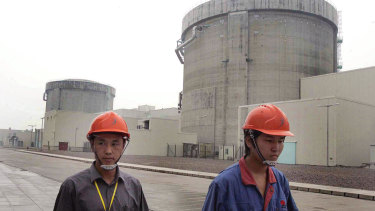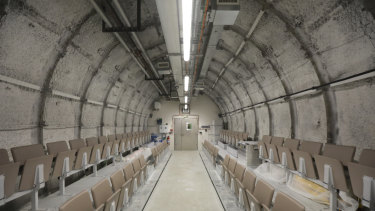Home » World News »
China targets nuclear fusion power generation by 2040
Hefei: China aims to complete and start generating power from an experimental nuclear fusion reactor by around 2040, a senior scientist involved in the project said, as it works to develop and commercialise a game-changing source of clean energy.
It is preparing to restart its stalled domestic nuclear reactor program after a three-year moratorium on new approvals, but at a state laboratory in the city of Hefei, in China's Anhui province, scientists are looking beyond crude atom-splitting in order to pursue nuclear fusion, where power is generated by combining nuclei together, an endeavour likened by sceptics to "putting the sun in a box".
Workers walk past Qinshan No. 2 Nuclear Power Plant, China’s first self-designed and self-built national commercial nuclear power plant in 2005.Credit:AP/File
While nuclear fusion could revolutionise energy production, with pilot projects targeting energy output at 10 times the input, no fusion project has up to now created a net energy increase. Critics say commercially viable fusion always remains 50 years in the future.
China has already spent around 6 billion yuan ($1.2 billion) on a large doughnut-shaped installation known as a tokamak, which uses extremely high temperatures to boil hydrogen isotopes into a plasma, fusing them together and releasing energy. If that energy can be utilised, it will require only tiny amounts of fuel and create virtually no radioactive waste.
Song Yuntao, deputy director of the Institute of Plasma Physics at the Hefei Institute of Physical Science, said on Thursday that while technological challenges remained immense, the project has been awarded another 6 billion yuan in funding, and new construction plans are underway.
"Five years from now, we will start to build our fusion reactor, which will need another 10 years of construction. After that is built we will construct the power generator and start generating power by around 2040," he said at the site, built on a leafy peninsula jutting into a lake.
A safety chamber at the Cigeo project, a nuclear laboratory and underground storage facility site in Bure, France. France is the world’s second-biggest producer of nuclear energy, just behind the US and just ahead of China. Credit:Bloomberg
China has been researching fusion since 1958, but at the current stage, it is still more about international cooperation than competition, Song said. The country is a member of the 35-nation ITER project, a €10 billion ($15 billion) fusion project under construction in France.
China is responsible for manufacturing 9 per cent of ITER's components, and is playing a major role in core technologies like magnetic containment, as well as the production of components that can withstand temperatures of over 100 million degrees Celsius (180 million degrees Fahrenheit).
ITER is scheduled to generate first plasma by 2025. A demonstration reactor will then be built, with the aim of creating 500 megawatts of power from just 50 megawatts of input, a tenfold return on energy.
Despite the critics who say dependable fusion energy is unrealistic, Song said he was confident breakthroughs are being made.
"Because we have a lot of technology now, a lot of challenges in plasma physics have been overcome, and I think this will speed up the entire process," he said.
Reuters
Source: Read Full Article




